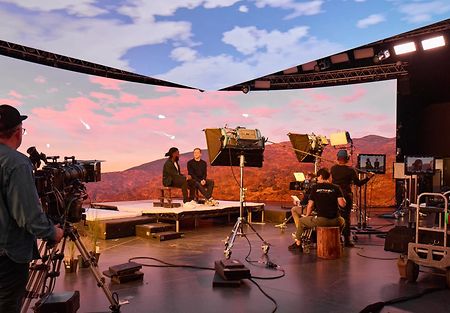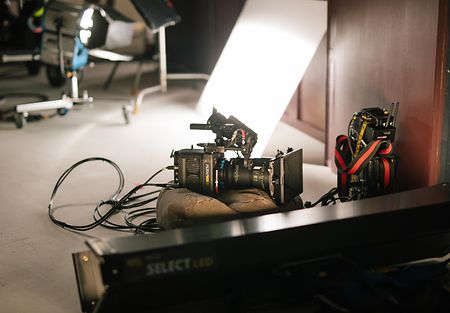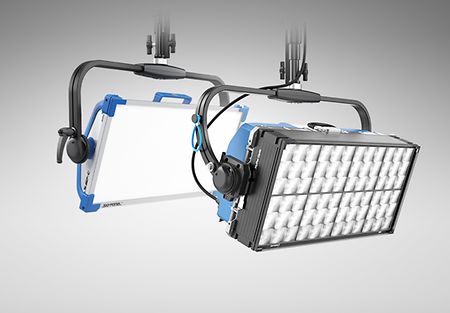Pioneering English electronic music legends, the Chemical Brothers, have always embraced cutting-edge technology. Continuing this groundbreaking approach, the promo for latest track “Live Again” utilizes virtual production to tell a story that could not be achieved in any other way.
Shot at ARRI Stage London and produced by Outsider, the promo follows a dancer emerging from her trailer into a series of various environments—with several scene transitions taking place live, within one continuous shot.
Using Unreal Engine’s sequencer tools, the Stage team from ARRI Solutions, Creative Technology, and Lux Machina provided the production with full 3D control over each environment in an animated sequence built by Untold Studio. Careful coordination was essential: virtual transitions, lighting sequencing, camera movement, set dressing, and atmospheric elements had to be choreographed and rehearsed down to the tiniest detail.
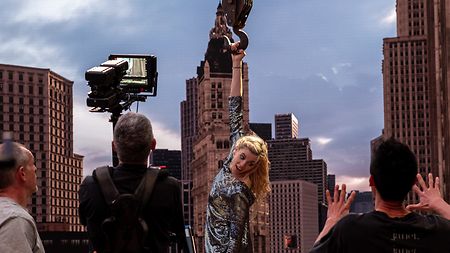
The shoot required careful choreography and coordination in front of, and behind the camera
ARRI spoke to directing duo and long-term creative collaborators, dom&nic, about translating their signature directing style into a virtual production environment.
How did you approach the creative content for the video, knowing that it would involve virtual production?
Music videos are such a treat to do; you get to break rules and do things that haven’t been seen before. Being immersed by ARRI Stage London and its walls of screens for the first time was very impressive. You start wondering how to use the space and the technology to create a narrative that couldn’t be shot in any other way.
Our main challenge was taking an unbroken shot through different environments without cutting or using greenscreen. Pre-shoot, we used Unreal Engine to design a range of immersive environments, so we could work out the space for our physical set and get a sense of how our actor and props could be positioned.
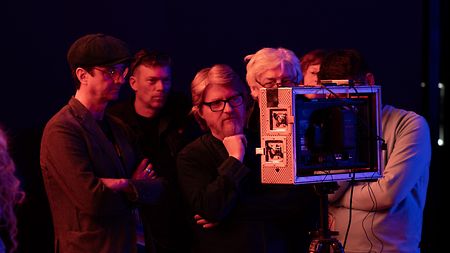
dom&nic, DP Steven Keith-Roach, and 1st AD James Sharpe review the action
Cutting-edge technology is a signature of your Chemical Brothers’ collaborations. How did you plan to translate your directing style into a virtual production environment?
Many of our previous films had months of postproduction, but this track needed a fast turnaround from concept to delivery. We knew ARRI Stage London and its brilliance at lighting the physical world with the virtual, which inspired a concept that used the space in a way that had not been done before.
The process was completely new to us, and we were also pushing virtual production to do things that had no precedent. Despite this, with the help of Untold Studio, Creative Technology, Lux Machina, and ARRI Solutions we worked through how to set up and move through multiple environments in one unbroken camera shot. After creating an effective ad-hoc workflow, we could encounter and solve problems as a team.
What were your expectations going into a virtual production shoot? Did they differ from your actual experience?
We anticipated that a clear working translation between a traditional camera crew approach and the virtual production elements might be difficult—but it wasn’t the case. Our DP, Steven Keith-Roach, worked with the Stage teams to light the scenes virtually, and with gaffer Kevin McMorrow to use practical and studio lights inside the caravan, which worked seamlessly.
The Stage’s wraparound design with real-time camera tracking and lighting is a great leap forward from traditional greenscreen—no edges or spill, and perfect reflections. The biggest factor for successfully integrating CGI and real-world is image-based lighting and ARRI Stage London’s process to utilize this for our actors, highly reflective set, props, and wardrobe is, by far, the biggest advance. The fact that foregrounds and backgrounds are shot in-camera, with no need to composite later is the icing on the cake!
As LED screens don’t give off the hard light that natural daylight does, we used softer lighting setups that worked well on the physical stage and helped the blend from set to screen. It was a very quick process to move the sun across the sky or pop it behind a cloud.
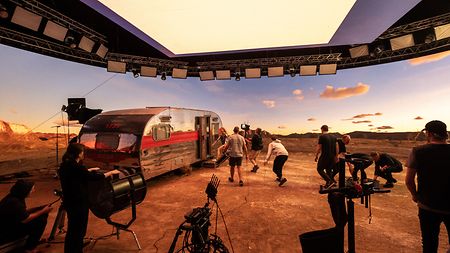
The shoot transitions seamlessly through multiple environments in one, unbroken shot
Were there specific features of the technology at ARRI Stage London that lent themselves well to supporting your creative vision?
The technology inspired ideas, but also showed us the constraints that needed creative solutions, which gave the film a unique style. Building a set that would transition for all environments was a creative challenge, but one that developed the idea further. For example, a desert floor could become a construction site in a city—once we had worked through that process, things started to tie together.
Connecting the Unreal environments with the actor and set wherever possible while using whatever tricks and ideas we could imagine was important. For example, CGI tumbleweed enters the frame, rolls around the physical set and then off into the 3D environment background. A black, disc-like object in the sky does the opposite: starting in the distance, in the Unreal environment, then right over the head of the actor in the set. Lighting was synced with the camera, and the black disc was also integrated as real-time VFX on the LED wall. This meant our actor could perform and react to the final image, which looked as ominous and convincing on the Stage as it does in the final film.
What was your overall experience of shooting at ARRI Stage London?
ARRI Stage London’s facilities are impeccable and a fantastic working environment. We couldn’t have asked for a more conducive environment to be creative in; from the make-up and wardrobe rooms to the stage itself. Everything has been well thought-out and planned.
The Stage’s team were genuinely so enthusiastic and supportive of the work and our lovely crew. They really took on a huge creative challenge to achieve this film. A great bunch to collaborate with, and we’d jump at the chance to do so again.


